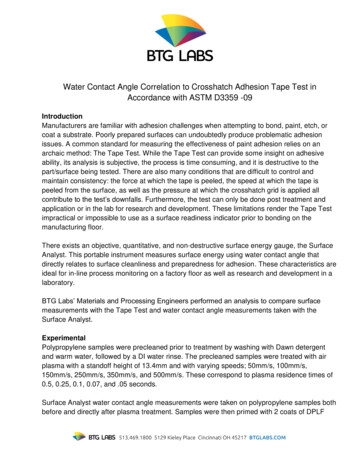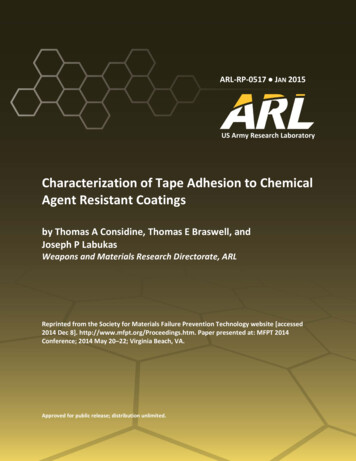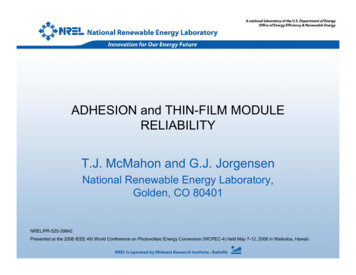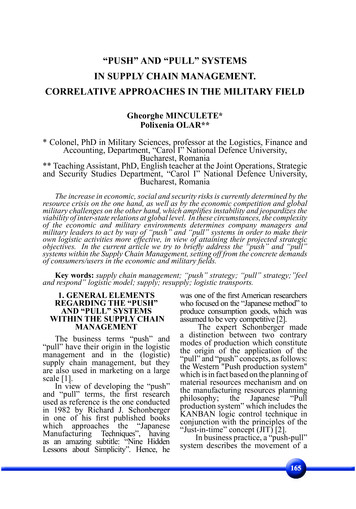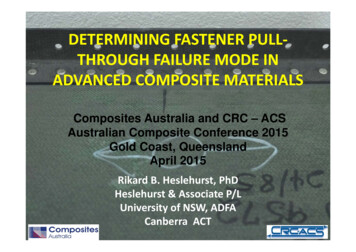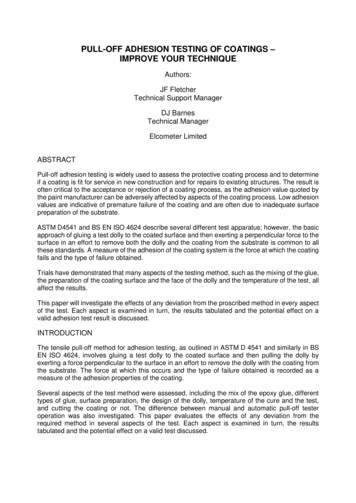
Transcription
PULL-OFF ADHESION TESTING OF COATINGS –IMPROVE YOUR TECHNIQUEAuthors:JF FletcherTechnical Support ManagerDJ BarnesTechnical ManagerElcometer LimitedABSTRACTPull-off adhesion testing is widely used to assess the protective coating process and to determineif a coating is fit for service in new construction and for repairs to existing structures. The result isoften critical to the acceptance or rejection of a coating process, as the adhesion value quoted bythe paint manufacturer can be adversely affected by aspects of the coating process. Low adhesionvalues are indicative of premature failure of the coating and are often due to inadequate surfacepreparation of the substrate.ASTM D4541 and BS EN ISO 4624 describe several different test apparatus; however, the basicapproach of gluing a test dolly to the coated surface and then exerting a perpendicular force to thesurface in an effort to remove both the dolly and the coating from the substrate is common to allthese standards. A measure of the adhesion of the coating system is the force at which the coatingfails and the type of failure obtained.Trials have demonstrated that many aspects of the testing method, such as the mixing of the glue,the preparation of the coating surface and the face of the dolly and the temperature of the test, allaffect the results.This paper will investigate the effects of any deviation from the proscribed method in every aspectof the test. Each aspect is examined in turn, the results tabulated and the potential effect on avalid adhesion test result is discussed.INTRODUCTIONThe tensile pull-off method for adhesion testing, as outlined in ASTM D 4541 and similarly in BSEN ISO 4624, involves gluing a test dolly to the coated surface and then pulling the dolly byexerting a force perpendicular to the surface in an effort to remove the dolly with the coating fromthe substrate. The force at which this occurs and the type of failure obtained is recorded as ameasure of the adhesion properties of the coating.Several aspects of the test method were assessed, including the mix of the epoxy glue, differenttypes of glue, surface preparation, the design of the dolly, temperature of the cure and the test,and cutting the coating or not. The difference between manual and automatic pull-off testeroperation was also investigated. This paper evaluates the effects of any deviation from therequired method in several aspects of the test. Each aspect is examined in turn, the resultstabulated and the potential effect on a valid test discussed.
ADHESIVE MIXINGThe test dolly should be glued to the surface using a suitable adhesive. Typically a two-pack epoxyadhesive is supplied with adhesion test units. The instructions for this type of adhesive state thatthe two components, resin and hardener, should be mixed in equal parts usually equal lengths ofboth parts. In order to achieve a more accurate mix, the amount of each component was measuredby weight using an accurate electronic balance.A test was carried out to understand the effects of mixing the adhesives incorrectly. 3 samples ofglue were mixed, a 1:1 resin (a) to hardener (b) ratio, a 1:2 hardener to resin ratio and a 2:1hardener to resin ratio. Unprepared dollies were stuck down on unprepared surfaces such that theonly variable was the glue mix. The adhesive strength was not optimised. The dollies were thenpulled using a manual Type V gauge.Set123Glue Mixratio(a:b)1:11:22:1Pull 1(MPa)Pull 2(MPa)Pull 3(MPa)Pull 4(MPa)Pull 0Average%PullvariationValue6.673.93-416.33-5Table 1 – Test Results for different ratios of two-pack epoxy glueThe average value is calculated excluding the maximum and minimum value in each set to avoidany skewing of the results due to any outliers. This approach was taken with all tests.In Table 1 the results show an average failure value of 6.67 MPa when the glue is mixed correctly.If too much resin is used, then the failure force reduces by 5%, which is quite small, but is outsidethe 1% stated accuracy of the gauge. However when the hardener quantity exceeded the resin,then a variation of -41% in failure strength was noted. It is unlikely that a user will mix the glue insuch an erroneous way, indicating that an excess of resin to hardener would have little effect onthe results, whereas too much hardener could still significantly affect any test results.COMPARISON OF TWO ADHESIVE TYPES:ISO 4624 has guidance on the selection of suitable adhesives. The relevant section is reproducedas Figure 1 below.Figure 1 – Extract from ISO 4624ASTM D 4541 states that the adhesive is for securing the fixture to the coating and that it does notaffect any coating properties. Two component epoxies and acrylic adhesives have been found tobe the most versatile.
Both specifications clearly state that there is no one single glue that can be specified for all coatingpull tests; rather, glue suitable for the conditions of the test should be used. The correct glue isone that has bond strength greater than the adhesive strength of the coating being tested.Different suppliers provide different adhesives with their adhesion test kits. Adhesives from thesame supplier are often made in different parts of the world and the locally available version maydiffer from location to location. Indeed, in some cases, certain adhesives may be unavailable ingiven parts of the world.The relative strength of Araldite Standard and Loctite Hysol were compared. These adhesives areboth commonly supplied in adhesion test kits but to highlight the point about availability, the Loctitewas sourced in the USA as it is unavailable under that name in the UK. 10 dollies were stuck downto an uncoated, unprepared steel substrate, 5 using Araldite, and 5 using the Loctite adhesive.The glue was allowed to cure for 24 hours and the dollies pulled from the teTest Value (MPa)5.87.58.710.78.312.212.914.612.511.0Failure TypeAdhesive Dolly/GlueAdhesive Dolly/GlueAdhesive Dolly/GlueAdhesive Dolly/GlueAdhesive Dolly/GlueAdhesive/Cohesive 80:20 Dolly/GlueAdhesive/Cohesive 50:50 Dolly/GlueAdhesive/Cohesive 50:50 Dolly/GlueAdhesive/Cohesive 30:70 Dolly/GlueAdhesive/Cohesive 50:50 Dolly/GlueTable 2 – Results for tests on a steel plateAs seen in Table 2, the values for the failure strength and the type of failure indicate that the Loctitehas stronger adhesive properties than the Araldite by approximately 4 MPa.Dolly12GlueAralditeAralditeTest Value ctite11.0Failure TypeAdhesive Glue/CoatingAdhesive ngAdhesive/CohesiveGlue/CoatingTable 3 – Results for tests on a painted steel panel50:5050:5080:2080:2010:9095:560:4050:50
Table 3 shows the results of a repeated test, this time on a coated surface. The average value forboth adhesives is the same, 10.33 MPa. However with either adhesive, the crucial factor is thatboth have sufficient strength to carry out a successful adhesion test.SURFACE PREPARATION“To reduce the risk of glue failures, the surface of the coating can be lightly abraded to promoteadhesion of the adhesive to the surface. If the surface is abraded, care must be taken to preventdamage to the coating or significant loss of coating thickness.”The preceding paragraph is taken from ASTM D 4541 and is not an instruction, rather asuggestion. A series of tests were carried out to examine the effect of preparing both the dolly andthe surface.4 sets of 5 dollies were glued to an uncoated surface with various combinations of preparation.The results for this test are shown in Table 4. Set 1 had both dolly and substrate prepared, Set 2has only the surface prepared, Set 3 has only the dolly prepared and for Set 4 no preparation wascarried out. After curing, the dollies were pulled from the surface and the failure value recorded.Set1234AveragePull1 Pull2 Pull3 Pull4 .9%-7%Table 4 – Results for the surface preparation trialsUsing Set 1 as the “control” where both the dolly and the surface were prepared there are somemarked differences to be seen when other combinations are utilised. If no preparation is done (Set4), then there is a 7% reduction in the average failure value achieved. Preparing the dolly alone(Set 3) results in a negative variance of just less than 5% whereas preparing the coating surfaceonly, (Set 2), results in a 15% reduction in failure value.The average failure value for each set indicates that preparing both surfaces increases thestrength of the bond between adhesive and coating, and adhesive and dolly. This greatly increasesthe chances of a successful test as the strength becomes greater than the specified coatingstrength. This leads to a further question: what level of surface preparation of the dolly should beundertaken for best results?Tests were carried out using sanded and blasted dollies on a blasted metal surface and the resultsare listed in Table 5 below.Dolly12345Average ValueSanded (MPa)8.710.311.314.810.810.8Blasted (MPa)10.014.214.411.913.413.17Table 5 – Test results for sanded and abrasive blasted dollies
These results clearly show that blasted dollies give a higher test value than a sanded dolly, in thiscase 22% higher.In subsequent discussions with adhesive suppliers, it was recommended that both dolly andcoated surface be abraded for their product to be most effective.VARIATION IN LOADING FIXTURE (DOLLY) DESIGN:Any reference to the dimensions of the dolly, in any of the relevant standards, is only arecommendation that the length (height) of the dolly be at least half the diameter of the dolly. Ifthis recommendation is taken literally, then most, if not all, commercially available dollies do notcomply with this recommendation because dollies are shaped rather than cylindrical. However,taking the “spirit” of this recommendation, the thickness of the base should be a consideration.Two designs of dolly were used, one having a base thickness of 4.0 mm (A) and the other athickness of 2.6mm (B). The two styles of dolly are shown in Figure 2. Test results are given inTable 6.Dolly Type ADolly Type BFigure 2 – Two dolly design typesPull12345Average value less outliersA (MPa)10.410.711.39.810.310.46B (MPa)9.48.29.18.88.58.8Table 6 – Comparison of two dolly designsNeither the dollies nor the un-coated surface received any surface preparation before the testingtook place; hence any variation in readings can be attributed to the geometry of the dollies, as thisis the only variable.Results show a 16% higher pull strength is required to remove the thicker based dolly from thesurface than the thinner based dolly. Video examination of tests carried out on glass showed that,in both cases, the dollies started to lift from the edges, but there was no discernible visibledifference in the mechanical action of the pull test on each dolly.TEMPERATURE OF ADHESIVE CURING AND PULL TESTINGTemperature and time of cure coupled with the temperature at the time of the adhesion test mayhave an effect on the results obtained. To investigate this, a series of tests were set up. Dollieswere glued to a coated surface, both having been prepared as per the recommendations containedin ASTM D 4541. Various cure times and temperatures were used, and the tests were carried outat different temperatures. Table 7 summarises the conditions and results.
Set123456Cure time(hours)2482424824Cure temp ( C)Test temp ( C)223050503030222250223022Test value(MPa)11.29.07.510.838.2310.43Table 7 – Results for tests at different temperaturesIt must be noted that no combination of cure and test temperature gives a higher test value thanthe “control” conditions of set 1. In attempt to speed up the process, set 2 was cured at 30 C for8 hours, a typical shift length, and pulled at room temperature with reduced results. These resultssuggest that under whichever conditions the cure occurs, the pull should be carried out at anambient temperature of 22 2 C.TO CUT OR NOT TO CUTISO 4624 states “ carefully use the cutting device (5.4) to cut around the circumference of thedolly through to the substrate, unless otherwise specified or agreed” whereas ASTM D 4541 states“Scoring around the fixture violates the fundamental in situ test criterion that an unaltered coatingbe tested. If scoring around the test surface is employed, extreme care is required to preventmicro-cracking in the coating, since such cracks may cause reduced adhesion values. Scoredsamples constitute a different test, and this procedure should be clearly reported with the results.”The different approaches by the two leading standards institutions as to the cutting of a dollyunderline the uncertainty of whether it is the best thing to do when carrying out an adhesion test.10 dollies were stuck down on a coated surface, 5 were left uncut, and the other 5 were cut oncethe glue had cured. Results are presented in Table 8.Dolly12345678910Cut or tTest result (MPa)10.38.510.510.510.69.79.69.010.69.2Type of alPartialPartialAdhesivePartialTable 8 – Test results for cut and un-cut coating“Partial” failure indicates a failure which is a combination of a partial cohesive failure of the coatingand a partial adhesive failure between the glue and the coating.Given the distribution of the partial type of failure, there was some thought that the cutting of thedolly once the glue had cured was affecting the bonding mechanism of the adhesive. Were microcracks being i
ASTM D4541 and BS EN ISO 4624 describe several different test apparatus; however, the basic approach of gluing a test dolly to the coated surface and then exerting a perpendicular force to the surface in an effort to remove both the dolly and the coating from the substrate is common to all these standards. A measure of the adhesion of the coating system is the force at which the coating fails .File Size: 494KBPage Count: 10
